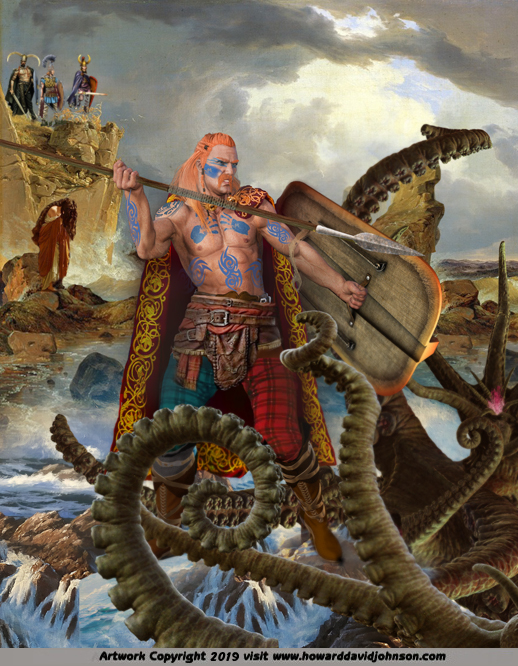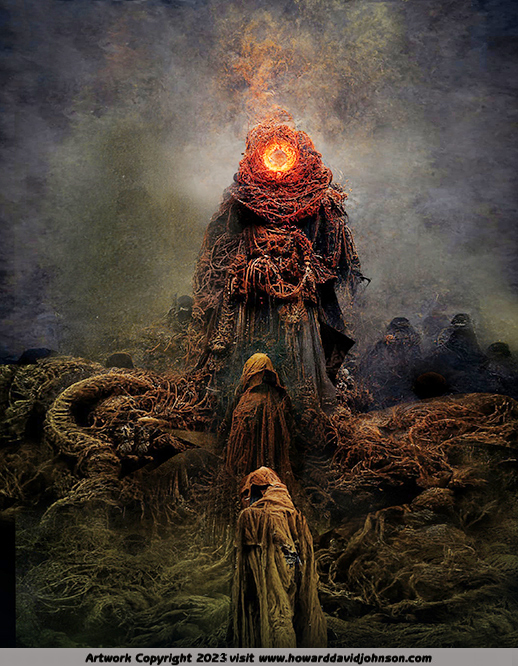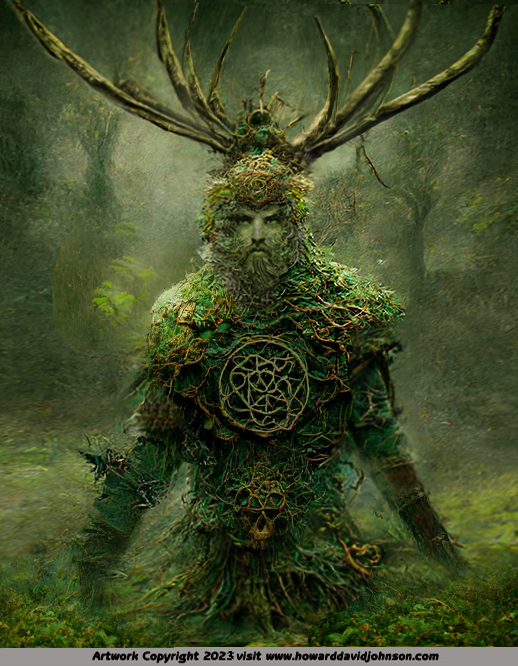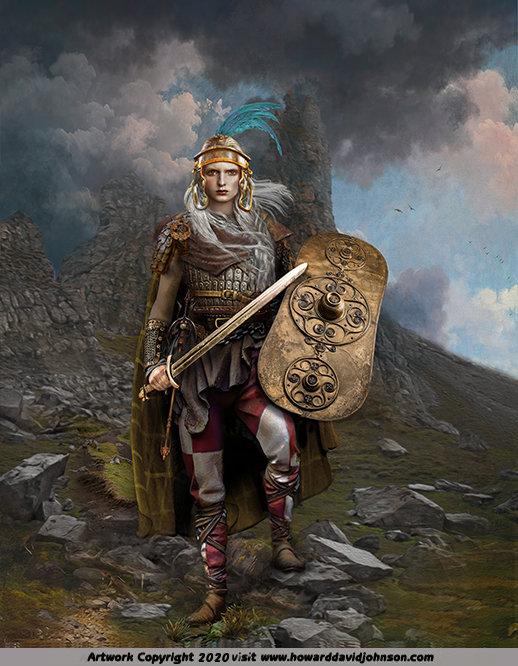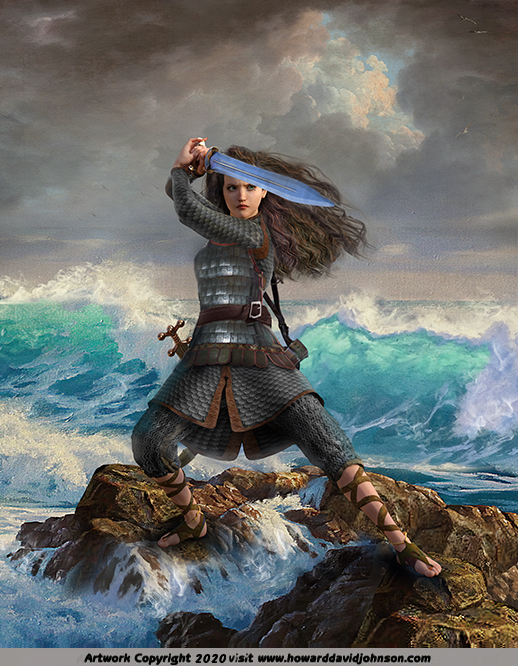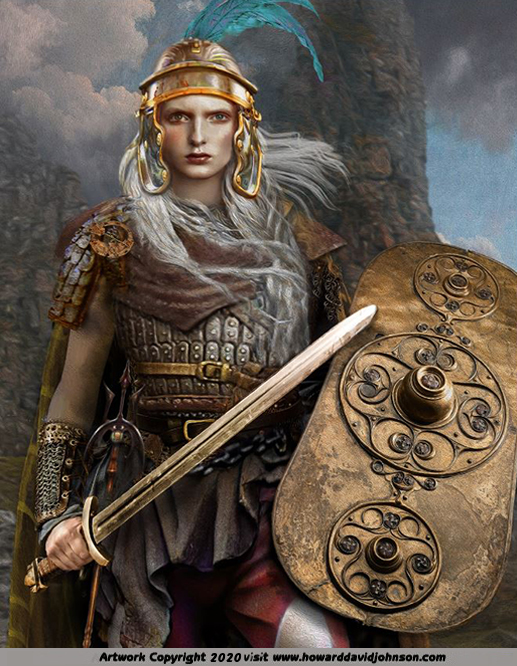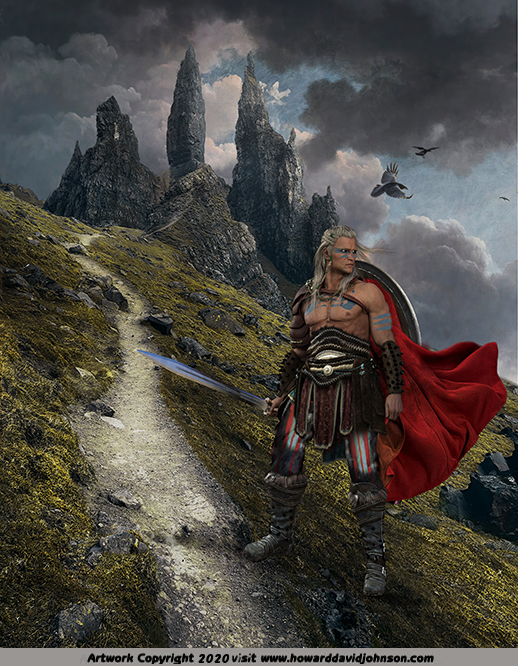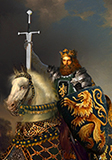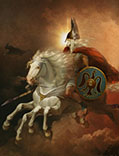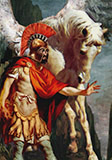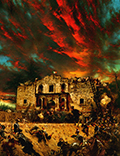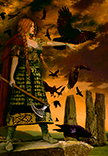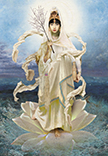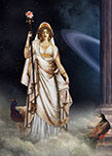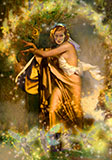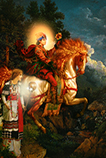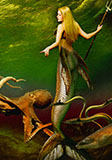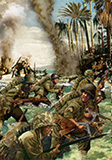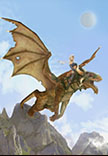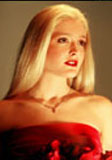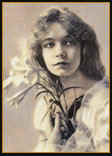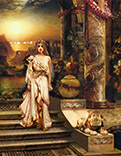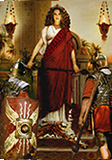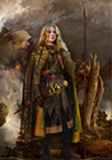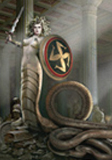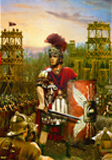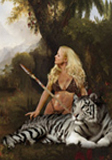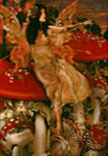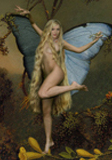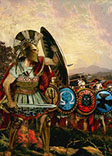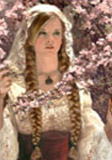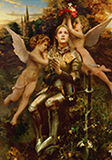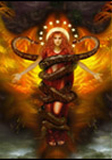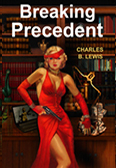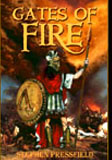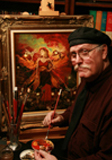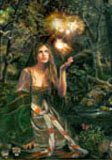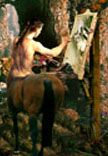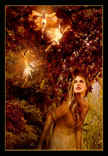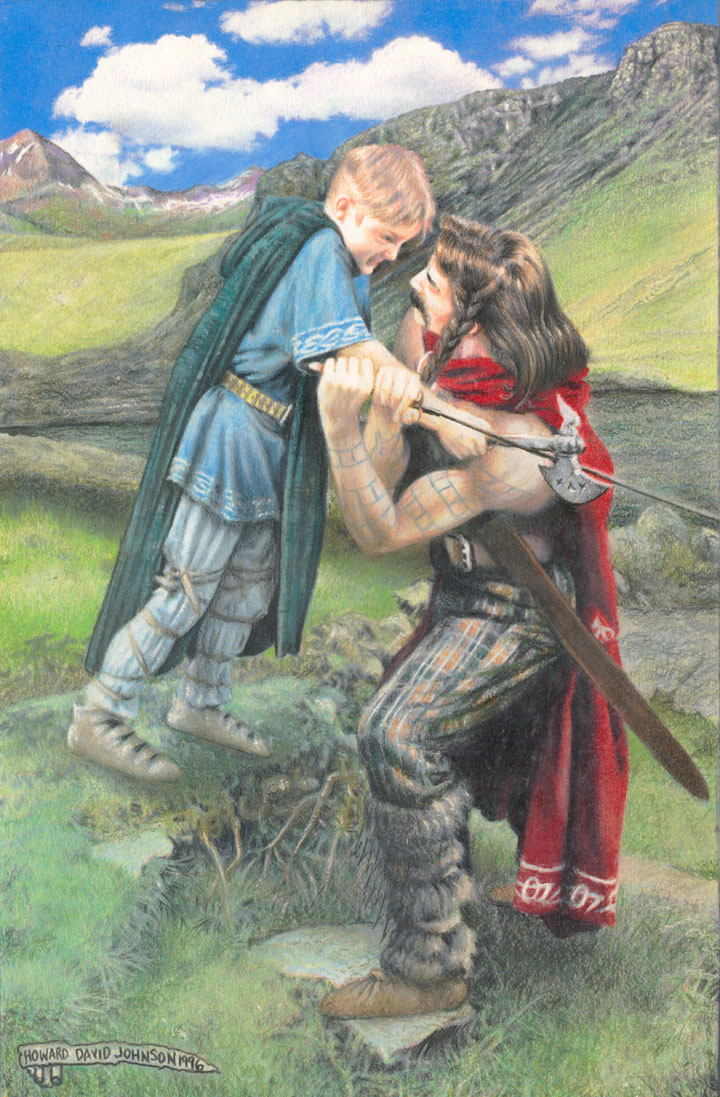Celtic Art: Celtic Mythology; realistic illustrations of Celtic Myths & Legends. An exhibition of Mythic Art by Contemporary American Illustrator Howard David Johnson, whose illustrations of Mythology, Folklore, Religion and History have been published all over the world by distinguished learning institutions and publishers including the Universities of Oxford and Cambridge.
|
"Manannán mac Lir" |

Presents: Contemporary Mythical Art Galleries: Gaelic Celtic Themed Artwork; A Gallery of New Illustrations~ Paintings, Drawings and Pictures from Celtic Mythology in oil paints, acrylics & colored pencils and digital media in a style inspired by classic illustrators. |
"Nuada's new hand of flesh and blood" |
|
The Gaelic Celtic Mythological Art of Howard David Johnson There are more than 33 million U.S. citizens of Irish ancestry, nine times the population of Ireland. I originally created these illustrations to share my Gaelic Celtic heritage with my children who also posed for some of them. This gallery is dedicated to my kinsmen, to kindred spirits everywhere, and to our children, and to our children's, children's, children...
|
||
|
"Cernunnos- Horned god of the Celts" The Green Man, Lord of the Animals is portrayed as human with an antler crown, and is protector of animals and law-sayer of hunting and harvest. He is also a tree, forest, and vegetation god, and his antlers symbolize the spreading treetops of the forest. |
When most people think of Celtic Art they think of design or abstract Celtic Art such as Celtic Knot work or Celtic Tattoo designs, ornamented tools, weapons, or jewelry. For centuries, there has been a shortage of Realistic Celtic Art and Illustration until recently a new generation has embraced it. Recently, there has been a world wide revival of interest in Celtic Art and Celtic Culture. Gaelic Celtic American Scientific and Historical Illustrator Howard David Johnson has worked from the latest archaeological and anthropological evidence to give us one of the most accurate views ever of the lost civilization of the Ancient Celts, whose mythology is a kind of enigmatic history. |
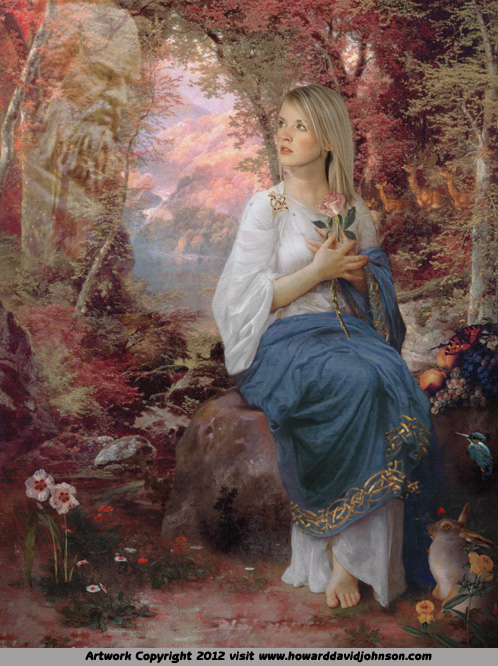
"Brigit" (AKA Saint Brigit) The Gaelic goddess of healers, smiths, childbirth inspiration and poetry which the Gaels deemed an immaterial, super sensual form of flame.. Her name means "exalted one"and she is considered the most important of the Dagda's children. |
|
Irish mythology is divided into four main cycles and each one of them embraces legends from their era and each cycle main has a certain world to evoke. These worlds could be ones of heroes and warriors or those of kings’ battles and history. These four cycles are the Mythology Cycle, the Kings’ Cycle, the Ulster Cycle, and the Fenian Cycle. The Tuatha de Da Naan, the Fomorians and The Red Branch Knights! The Tuatha Dé Danann (Irish for "the folk of the goddess Danu"), also known by the earlier name Tuath Dé or "tribe of the gods" are a supernatural race in Irish mythology. They represent a mythological pantheon of deities of pre-Christian Gaelic Ireland. The Tuath Dé dwelt in the Otherworld but interacted with mortals in the human world. They were associated with ancient portals to and from the Otherworld. |
||
|
Balor Balcbéimnech (the strong smiter) The Dark lord of the Fomorians- enemies of the Tuatha De Nanann Said to have come to Ireland from the underworld up through the depths of the sea...Balor the tyrant is often described as a giant with a large cyclopean eye that wreaks destruction when opened.
|
Their rivals are the Fomorians (Fomoire),who represent harmful or destructive powers of nature and who are defeated by the Tuath Dé in the Battle of Mag Tuired. (Moytura) The Fomorians were said to be a race of supernatural bloodthirsty, warrior giants which came from the underworld and were said to possess power over natural phenomena, in particular destructive elements. Fomoire may mean “demons from below (the sea)" The Fomorians are often described as monstrous, hideous-looking monsters with a single leg, arm, or eye. Irish legends tell many tales of the supernatural Fomorians. |
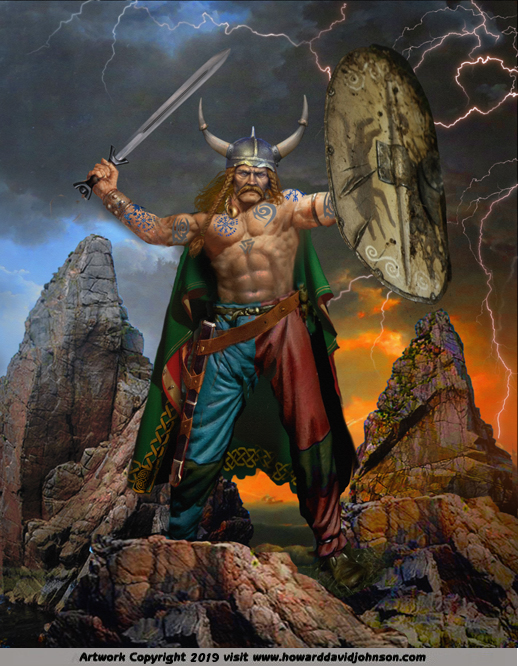
Nuada - the Celtic god of War King of the Tuatha De Nanann. Nuada Airgetlám (Nuada of the Silver Hand) was god of the sea, healing, and warfare, linked to Roman gods Mars and Neptune and also the Norse god Týr. He is also associated with the sun, youth, beauty, writing, swords and sorcery. |
| Each member of the Tuath Dé has associations with a particular feature of life or nature, but many appear to have more than one association. They often depicted the Tuath Dé as kings, queens and heroes of the distant past who had supernatural powers. Some times they were explained as fallen angels [the Watchers] but some medieval writers called them gods. They were descended from Nemed, leader of a wave of inhabitants of Ireland. They came from four cities to the north of Ireland ~Falias, Gorias, Murias and Finias, where they taught their skills in the sciences, including architecture, the arts, and magic, including necromancy. | ||
|
The
chieftain gods of the Tuatha dé Danann secured and
advanced the welfare of the people with supernatural powers
and magical
treasures, the Cauldron of Dagda, the Spear of Lugh, the Sword of Nuada
and the Stone of
Fàl.
The men were the Dagda, Lugh, Nuada, and the women were Danu, Anu, Brigit, and Emain Macha. Chief members of the Tuath Dé include The Dagda, the chieftain; The Morrígan; Lugh; Nuada; Aengus; Brigid; Manannán, a god of the sea; Dian Cecht, a god of healing; and Goibniu, a god of metal smithing and one of the Trí Dé Dána ("three gods of craftsmanship"). Their tales are set centuries apart, showing them to be immortals. They were banished from heaven because of their knowledge and descended on Ireland in a cloud of mist. |

Lugh with Balor's severed head at the battle of Mag Tuired ( pr. Moytura) At the last Battle of Mag Tuired (pronounced Moytura) Lugh, son of Nuada the king avenges his father's death on Balor by casting a spear crafted by Goibniu, Lugh then beheads Balor and his evil eye destroys the Fomorian army and his deadly eye beam kept blasting until it burned a hole into the earth. The hole filled with water and became a lake which is now known as Loch na Súl ("lake of the eye") |
Some people claim that their origin goes
back to Atlantis; The Leabhar Gabhála (Book of Invasions), treats them
as actual people migrating to Ireland and encountering the Fir Bolg and
the Fomorians.
Both races fought for control of Ireland. Legends have it that their first battle took place near the Shore of Lough Corrib on the Plain of Mag Tuired. Eventually, victory was on the side of Tuatha de Danann; they won the battle and took over Ireland. Their king died in the battle and they had to choose another leader. Eventually, the choice fell on Srang; he was the new leader of the Firbolgs. The battle did not end with the defeat of the Firbolgs; both races agreed to compromise, the Firbolgs only took Connaught while the rest of Ireland was given to the Tuath. |
| In the First Battle of Magh Tuiredh, King
Nuada of the Tuatha Dé Danann lost his hand and Nuada had his hand
replaced with a silver one by Dian Cecht and Creidhne, but because he
was imperfect, he could not be king. Dian Cecht, the great healer with
the help of his son Miach, and his sister Airmed restored the wounded
of the Tuatha dé Danann after the battle.
The Dagda ~ the Celtic All-Father
|
||
| The
Dagda
was foremost among the chieftain gods of the Tuatha dé Danann. He
was a father-figure, a warrior king, associated with fertility,
agriculture, manliness and strength, as well as magic, druidry and
wisdom.
In the Cath Maige Tuired, he reveals that his true name is Fer
Benn ("horned man"), like the horned god of the forest, Cernunnos. But
Dagda continues, relating that his complete name is Fer Benn Bruach
Brogaill Broumide Cerbad Caic Rolaig
|

"The Dagda and his harp, Uaithne" The Dagda (Celtic: “Good God”) was also called Eochaid Ollathair (“Eochaid the All-Father”), or In Ruad Ro-fhessa (“Red [or Mighty] One of Great Wisdom”), in the ancient Celtic religion, one of the leaders of a mythological Irish people, the Tuatha Dé Danann (“People of the Goddess Danu”). The Dagda mated with the sinister war goddess Morrígan. |
The Dagda was
said to be able to control time and the seasons with Uaithne. This was
how he stopped the sun when his lover Boann was pregnant with his son
Angus Og.
The harp’s music could overcome fear on the battlefield commanding order in battles or play three types of music which caused emotion, inspiring great sorrow, joy, or sleep and dreaming. When Fomorians stole the harp, the Dagda discovered the keep where it hung upon a wall. The harp magically flew to his hand when he called it, killing nine men. Dagda then used Uaithne, causing his enemies to cry and laugh uncontrollably, then to fall asleep and dream.
|
| The
Dagda
possessed great treasures, fruit
trees that were never barren, and two pigs—one live and the other
perpetually roasting, a huge club that had the power both to kill men
and to restore them to life, the Cauldron of Plenty (the coire ansic, or
cauldron which is never dry), sometimes referred to as the Undry. It
was never empty of food and could also be used to restore life to
fallen warriors.
|
||
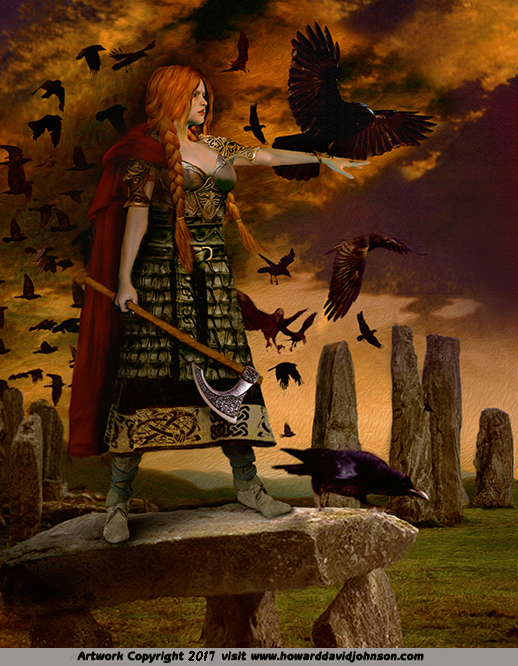 |
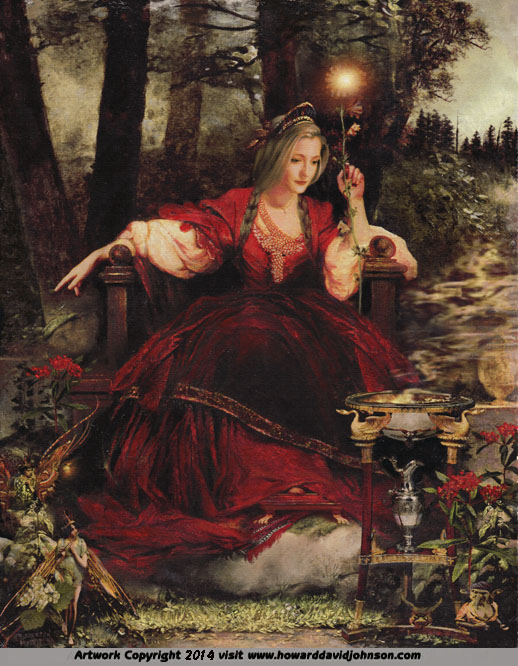 |
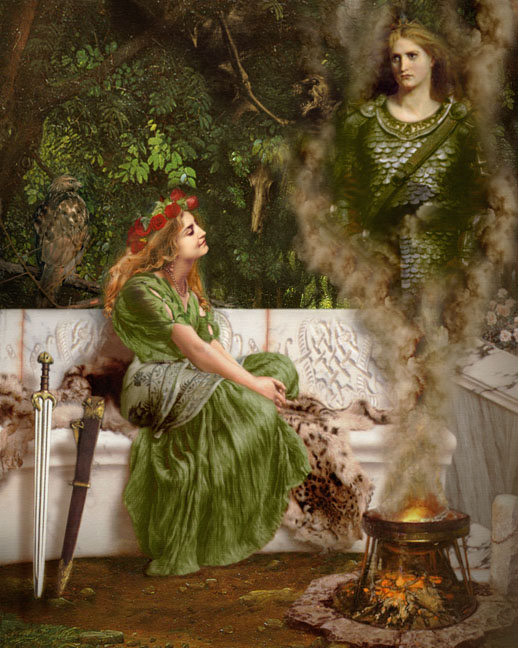 |
| "The Morrigan" [aka The Morrigu]" | "Queen Mab, the Bringer of Dreams" | "Celtic Queen Boudica and the Morrigu" |
|
The Morrigan or the Phantom Queen was the wife of the Dagda, and Gaelic goddess of War associated with battle, warriors, and bloodshed, as well as battle sorcery and prophecy known for appearances in bird form. Similar to Valkyries in Norse/Germanic culture, gathering the souls of the slain. The Heroes of Ulster, the main focus of our exhibit, have no part in fairyland, but their enemy, Medb or Mave is credited with Queenly rule among the Sidhe ( Fairies ) and is held by some to be the original "Queen Mab" The Divine Couple
|
||
| "No Irish king might rule who does not unite with the goddess of the land." One of the basic precepts of Celtic religion, according to Marie-Louise Sjoestedt, is that of the marriage between the chief god and “one of the Matres” [those trios of goddesses found in Celtic iconography where there existed the tradition of the territorial goddess marrying a mortal consort], to bless the land and ensure its fertility.” Hoping to reconcile relations between the Fomorians and the Tuatha Dé Danann after the Battle of Maige Tuired, (Moytura) the beautiful and intelligent Fomorian nobleman Bres mac Elathan is crowned king by reason of marriage to Brigit of the Tuatha De Danann, daughter of the Dagda, a Drudic Priestess, and goddess of poetry and all the wisdom contained therein. | 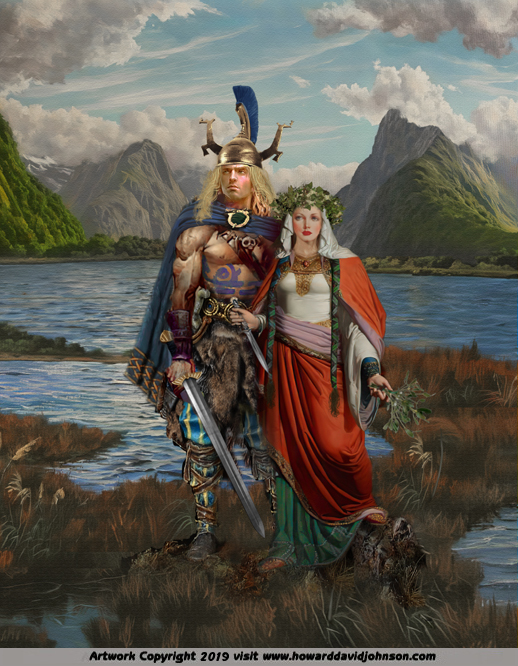
“The Mythical Pairing of Brig and Bres” Their ritual union on the day of Samain when the Celtic year is born, is to guarantee the ever-renewed vitality of the tribe... This connection was hoped to bring the two peoples closer together. |
Brigit is considered a goddess of antiquity and greatness; why then was she married to a man who epitomizes failure in kingship? Bres’s reign began well, but the cruel taxation imposed by the Fomoire during his reign lead to opposition. This tragic story reverses the intent of sacral kingship, where the marriage of king and goddess promote the prosperity of the land. \ Bres made the Tuatha Dé Danann pay tribute to the Fomorians and work as slaves: Ogma was forced to carry firewood, and the Dagda had to dig trenches around forts. He neglected his duties of hospitality: the Tuatha Dé complained that after visiting his house their knives were never greased and their breaths did not smell of ale. |
| Brigid gave Bres a son,
Ruadan, who would later be killed trying to assassinate Goibniu, the
legendary smith of Ireland and everything went wrong for Bres after
that leading
to his demotion and death.
The Druidic Healers of the Tuatha De Danann Healing the wounds of Battle ~ Knowledgeable in the Healing arts, Ancient Druids skillfully used herbs and plants for each affliction. In wartimes, they would craft a special well in the camp, using the most powerful plants to turn this into a magical health spa. In the first battle of Mag tuiread we are told: "They brought healing herbs and crushed and scattered them on the surface of the water in the well, so that the precious waters became thick and green. Their wounded were put into the well and immediately came out whole."
|
||
| Dian Cécht ( Pronounced Dye
an SET, also known as Cainte or Canta) was the god of healing and
legendary physician for the Tuatha Dé Danann.
He was a master of Druidic arts and the father of Miach, Airmed, Cu, Cethen Cian, Ochtriullach and Étan the poet . When Nuada was forced to abdicate after losing his hand in the first Battle of Mag Tuired since the king must be perfect in body, Dian Cécht crafted a new one for him, made of silver that functioned in every natural way. |
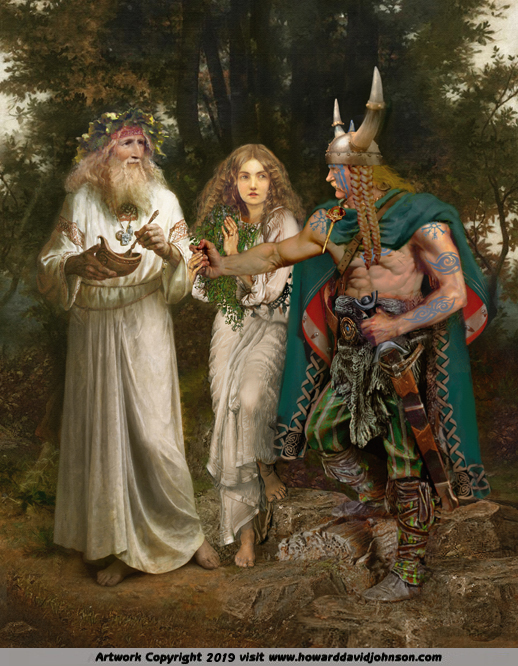
“ Dian Cécht, Airmid and Nuada's new arm of flesh and blood “
|
After Bres had
ruled for seven years, Nuada had his severed hand, previously replaced
with a silver one by Dian Cécht and Creidhne,replaced with one of
flesh and blood by Dian Cécht 's son Miach, with the help of his sister
Airmed.
Following the successful replacement, Nuada was restored to kingship and Bres was exiled, but Dian Cécht, furious that his son Miach's skills had surpassed his own, killed him. After being exiled Bres went to his father for help to recover his throne, |
| but
Elatha would not help him gain by foul means what he had been unable
to keep: "You have no right to get it by injustice when you
could not keep it by justice". Bres father directed him to
Balor,
another leader of the Fomorians, for the help he sought. He led
the Fomorians in the Second Battle of Magh Tuireadh but lost. In the
Dindsenchas
Bres is killed at the hand of Lugh, who made a bitter, poisonous
red liquid which was then offered to Bres to drink. Bres, who was under
an obligation not to refuse hospitality, drank it down without
flinching, and it killed him. The Lebor Gabála mentions this incident
briefly, however the deadly liquid is identified as sewage.
The Green Man ~ Guardian of the Forest
|
||
|
The Green Man in Celtic Mythology was a sort of forest-god, an emblem of the birth-death-rebirth cycle of the natural year. Not a human-like god of the forest so much as a living part of the forest itself that could manifest in a semi-human form.
The Ancient Celts worshipped him in hope of good harvests, and that he continues to guard the metaphysical gate between the material and immaterial worlds.”
The Green man was not just a figure of Celtic myth and folklore~ |
“ The Green Man" The origins and nature of the Green Man are unknown and there are scholars who believe that the idea of the figure arose independently in folklore and traditions, explaining its widespread appearance. |
In fact, evidence of his legends have been found all around ancient
Eurasia. For such a well known
or even ubiquitous figure, the Green Man of folklore remains surprisingly mysterious.
These early sculptures – and, indeed, most visual representations of the Green Man seen throughout history – show a humanoid face, usually shaped from leaves and other vegetation.
|
Scáthach (Scottish Gaelic: Sgàthach, Scathach, ) was the most fearsome warrior woman of old Irish legend. Her name means “the shadowy one” in Gaelic and she trained great soldiers at her school for heroes. In the legends, dying while training with Scáthach wasn’t at all unusual. Scáthach’s training was notoriously intense as she taught skills like pole vaulting over castle walls and underwater fighting. If her trainees didn’t survive her regimen, then her charges simply weren’t worthy."The Warrior Maid" was also the rival and sister of Aífe, both of whom are daughters of Árd-Greimne of Lethra; If you wanted the honor of training with her, first you had to find her.
|
||
|
" Scáthach ~ Teacher of fighters on the Isle of Skye" Scáthach taught Cú Chulainn all the arts of war, including the use of the Gáe Bulg, which was a terrible barbed spear, thrown with the foot, that has to be cut out of its victim. |
Finding Scáthach? Indeed, before any warriors could even ask Scáthach for help, they had to first find and then reach her domain. The woman’s fortress, called Dun Scaith (Castle of Shadows), reportedly sat on Isle of Skye northwest of Scotland. Kings and princes who wanted to get there had to cross the
Irish Sea, known for its deadly storms and choppy waters, eastward or
navigate the cold waters of the Atlantic northward along the craggy
islands of western Scotland. |
|
| Scáthach's
instruction of the young
hero Cú Chulainn; In
Ireland’s mythological epic, the Táin Bó Cúailnge, it was said of him
"You will not
encounter a warrior harder to deal with, nor a spear-point sharper or
keener or quicker, nor a hero fiercer, nor a raven more voracious, nor
one of his age to equal a third of his valour.”
Heroes, Monsters and Magic The heroes of the Celts, although of divine ancestry are in a different category than the gods of the Gaelic Celts, just as Perseus and Siegfried are sons of Zeus and Woten in Greek and Nordic mythology. The Red Branch Knights served Concobar mac Nessa, king of Ulster, a province of ancient Ireland. |
||
|
The greatest Red Branch commander was
Cú
Chulainn, a demigod, the mightiest of the heroes of Irish romance.
The other chief heroes were Conall Kernach; Laegaire (or Laery) the Victorious; Keltar of the Battles and Fergus mac Roy.
These Red Branch
Knights, and their contemporaries, heroes of Munster and Connaught,
fought, rode, and raced in chariots; and that they erected immense duns
or forts like Emain Macha that were spread all over Ireland. |
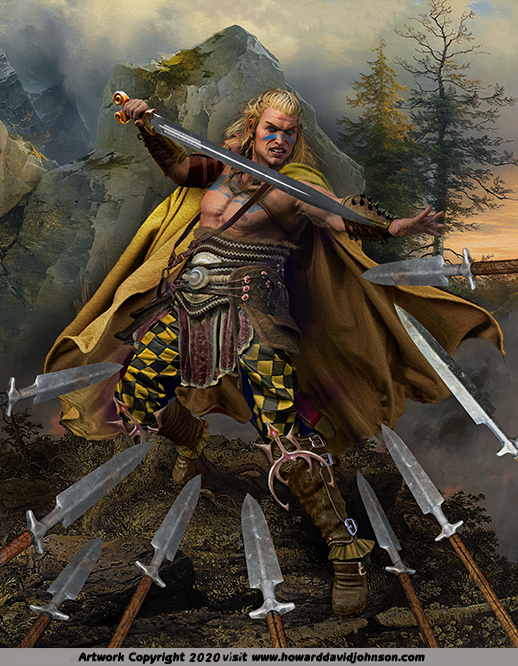 "Queen Mave betrays Cú Chulainn" |
Cú Chulainn notably appears in Tochmarc Emire (AKA The Wooing of
Emer), called the Irish Iliad, it was an ancient folk tale preceding the great epic Táin Bó Cúailnge. (AKA The
Tain, or the Cattle raid of Cooley)
In it, Cú Chulainn was said to be so beautiful and highly skilled that the men feared their women were unable to control themselves and it was decided he must find a bride and marry as soon as possible. None of the choices brought to him were to his liking so he set out to find a bride on his own. |
| .
"Cú Chulainn son of Lugh"
|
" Scátha" (zoomed in for close-up)" |
"The Search for Scatha" |
|
For more on the Legends of Cú Chulainn, Click on the promo image
below for a link to a gallery with DOZENS of paintings!
|
||
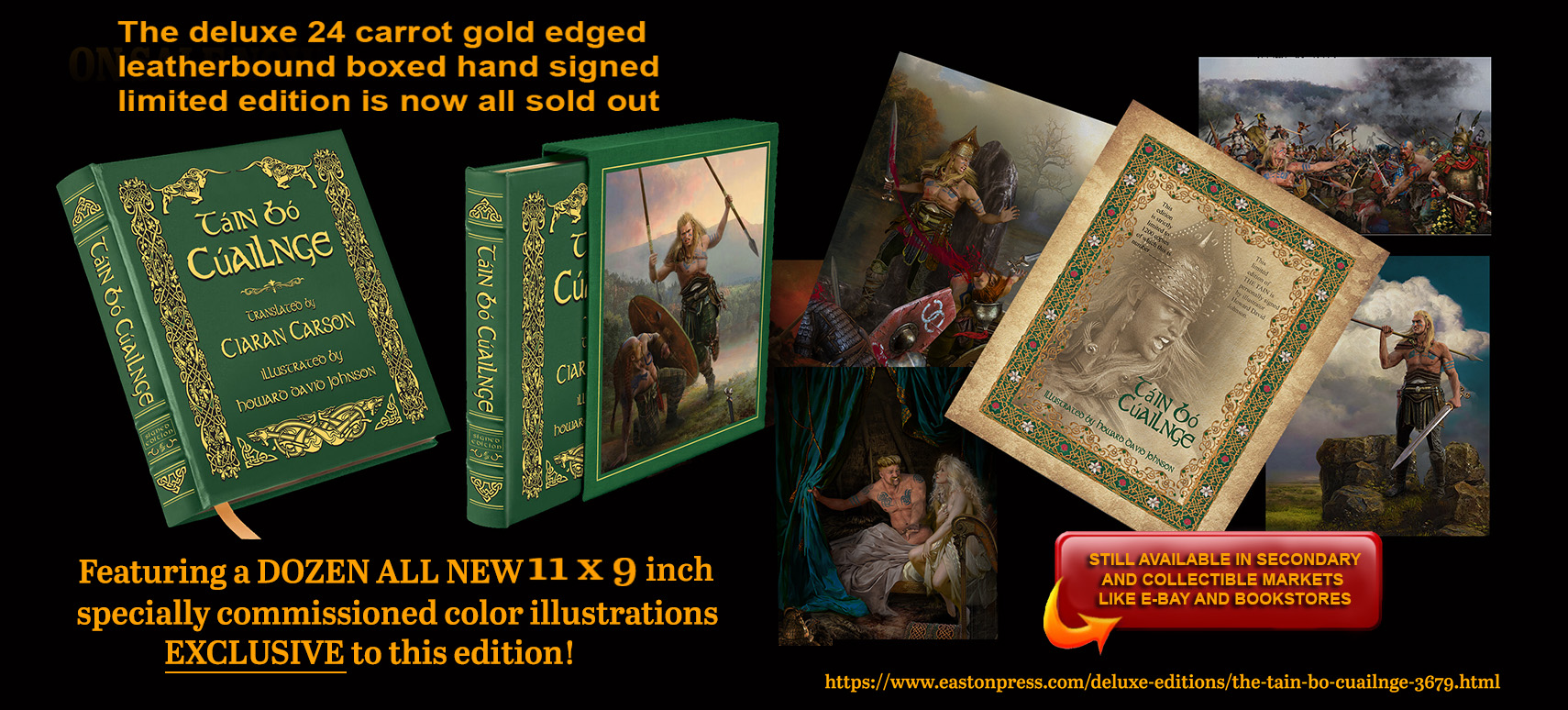 |
||
|
|
||
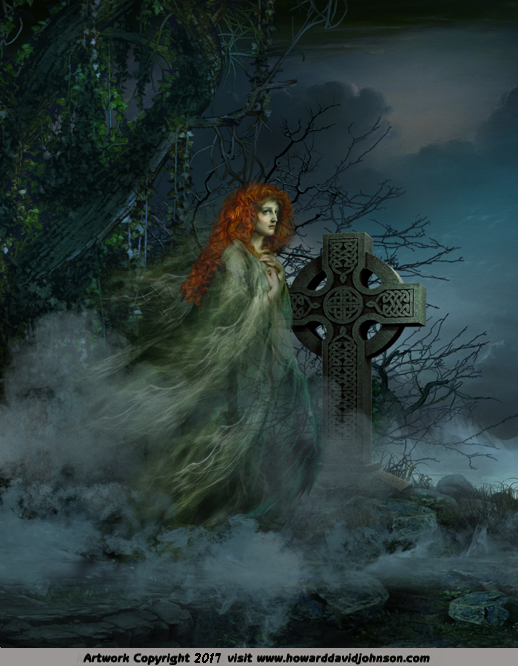
"Aibell the beautiful Banshee" |
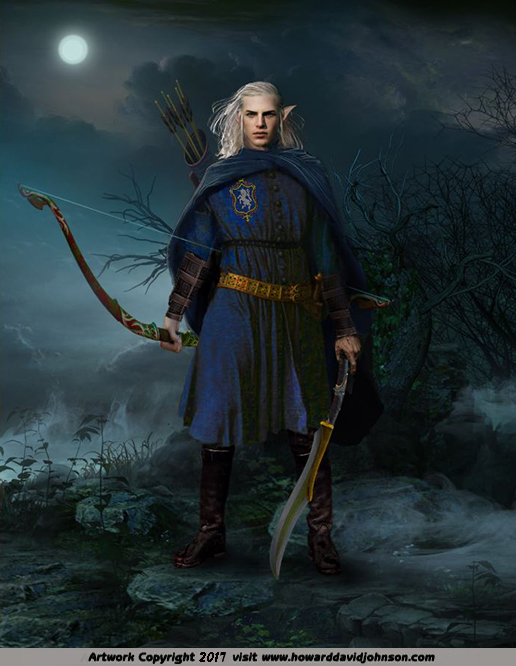
" Dubhlainn Ua Artigan" |
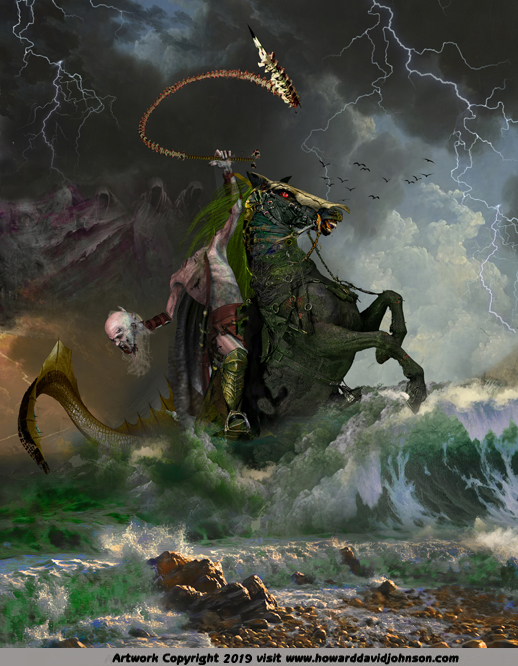
"The Dullahan on the Kelpie" |
|
The Dullahan or The Headless Horseman Gan Ceann or "without a head" in Irish.is a type of fairy in Celtic Mythology. He carried a whip made from the spines of human corpses and wore a hideous grin and roving eyes that could see for miles in the dark. Those who see him ride by have blood thrown in their faces or are struck blind in one eye. When the Dullahan stops riding and calls someone's name that person dies. The mystic black steed is a Water Kelpie that can send sparks or flame from it's hooves and nostrils. Sizable bodies of water in Scotland have Kelpie legends, the most famous of which is the Loch Ness Monster. Parallels include the Greek Hippocampus, the Scandinavian Backahast or the Germanic Neck or nixie. The lowland name of a demon in the shape of a horse.
|
||
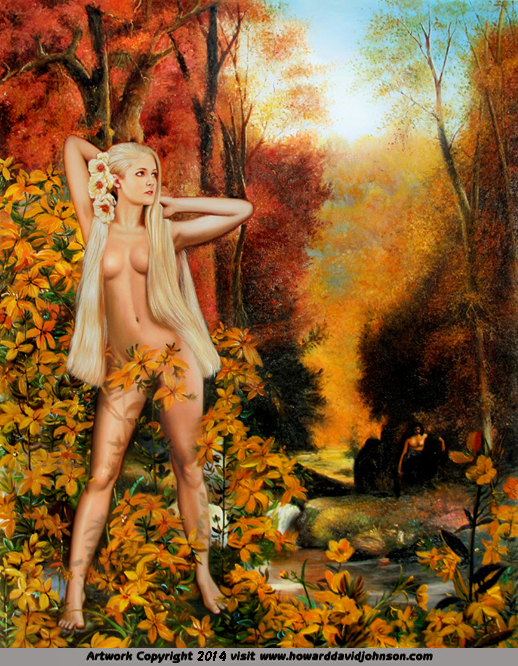
"Blodeuwedd and Gwydion" |

"Prospero's Faeries" |
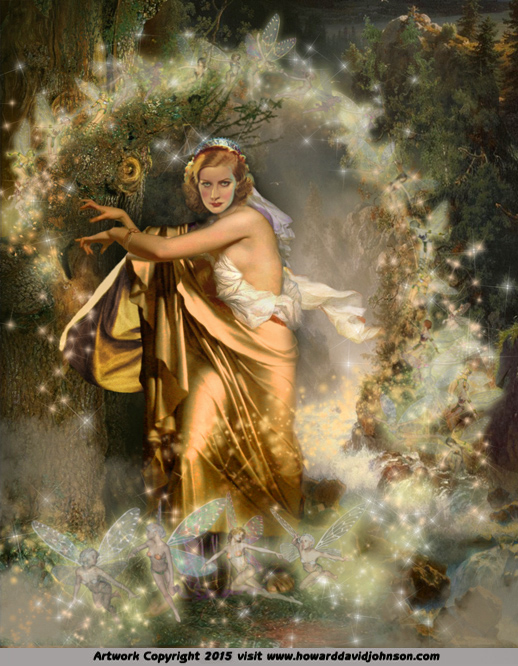
"Morgan Le Fey" |
|
Blodeuwedd means "born of the flowers" and is Welsh Celtic Mythology in English from "The stories of the Mabinogion" translated by the Lady Charlotte Guest AKA The White book of Rhydderch (Llyfr Gwyn Rhydderch) finally written in Welsh ca. 1350 & the Red Book of Hergest (Llyfr Coch Hergest) ca. 1382-1410.
|
||
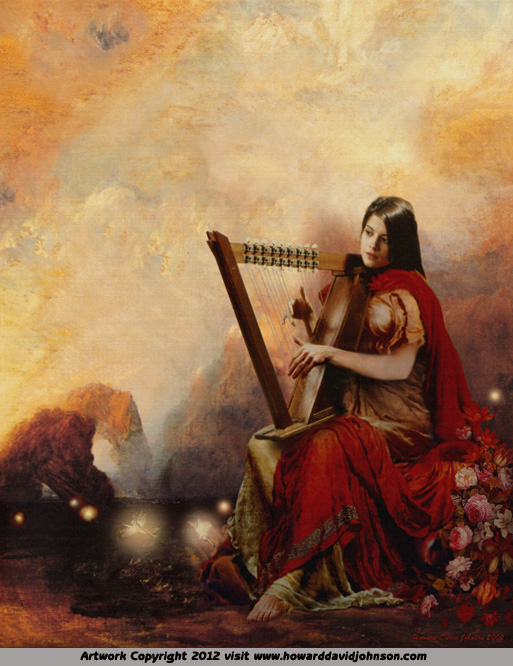 |
 |
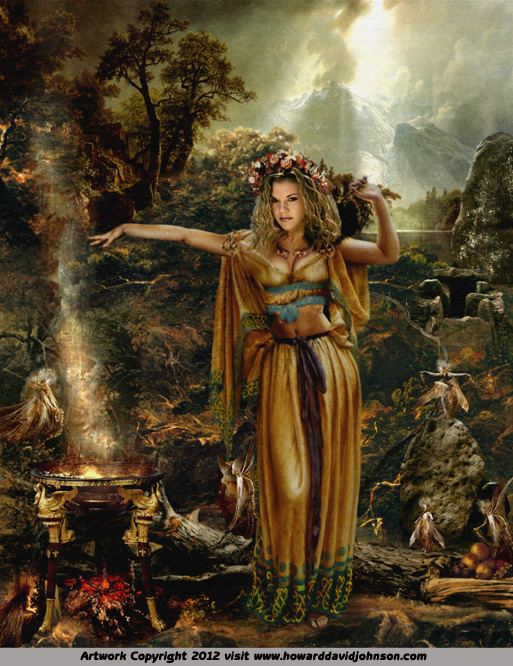 |
| "The Celtic Harpist" | "FAE Lament" | "Fairy Queen Medb" [Mave] |
|
Queen Medb (aka Maeve, Madb or Mave ) is credited with Queenly rule among the Sidhe (Fairies) and is held by some to be the original "Queen Mab". The Red Dragon
|
||
|
"The Red Dragon" or "Y Ddraig Goch" in Welsh,
is
the symbol of Wales and adorns its national flag. This dragon was
featured on the legendary battle standards of King Arthur, the heathen
Celtic gods and historic chieftains and kings.
The Red Dragon was first brought to Great Britain during the Roman era and history tells us they first learned of it from the Persians. The Red Dragon or 'draco' symbol was used as a standard by the Roman army but over time it was adopted by the Welsh people as their national flag. It is the oldest extant national flag flying today. |
"Y Ddraig Goch" or "The Red Dragon" |
In Celtic mythology Aibell (below - was also called Aoibheall (Aeval) was the guardian spirit of the Dál gCais, the Dalcassians or Ó Bríen clan. She was the ruler of the sídhe (SHEE) or the fairy people of Irish folklore, said to live beneath the hills and identified as the remnant of the ancient Tuatha Dé Danann. Her dwelling place was Craig Liath, the grey rock, a hill overlooking the Shannon in Cúige Mumhan a province in Southern Ireland. Legends tell us Aibell had a lover named Dubhlainn Ua Artigan and a magic harp whose melody foretold immanent death. |
|
The King Arthur Legends' Celtic Origins: It is now generally regarded as fact that the Celtic legends of history surrounding the medieval King Arthur and Guinevere are really derived from the Religion of the Ancient Britons ( Celts ) and the attributes and events of the life of King Artaius and Gwenhwyvar of the British gods have been applied to the actual historical King Arthur and Queen Guinevere in an attempt to preserve the oral traditions of their ancient Celtic spiritual and cultural heritage against the persecution of the Romans during the dark ages... Merlin was Myrddin, Mordred was Medrawt, Galahad was Gwalchaved and Sir Kay was Kai. Was The Lady of the Lake a Celtic lake divinity in origin, the same kind as the Gwagged Annwn? Or was she originally a lake fairy from Welsh folklore. Of many, Vivienne is the best choice for the name of this Lady of the Lake - the one who also enchanted Merlin and imprisoned him forever.
|
||
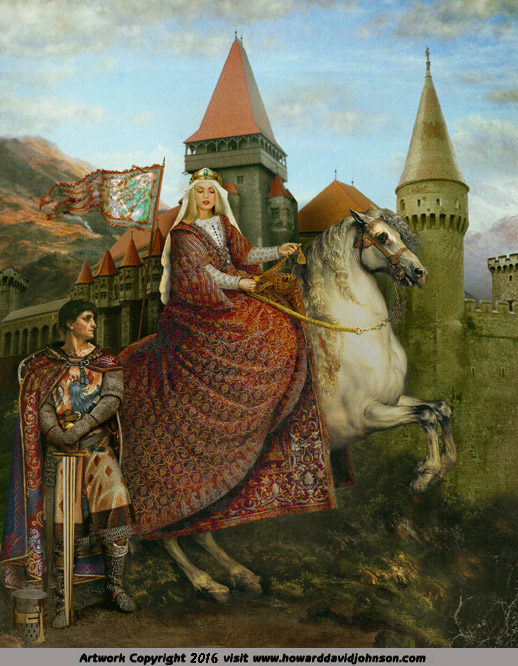 |
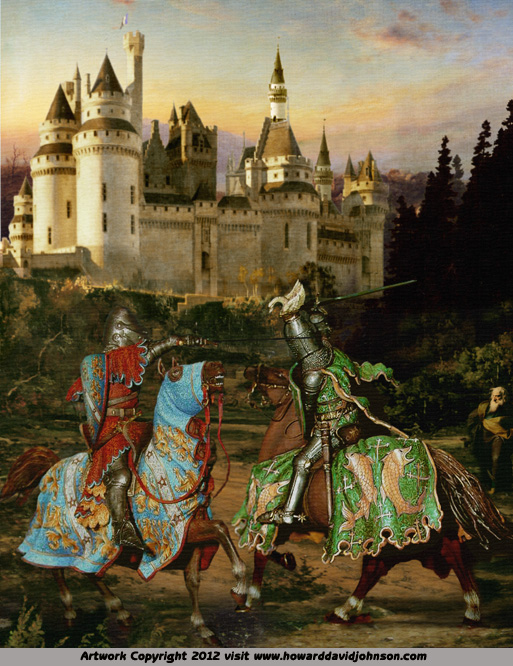 |
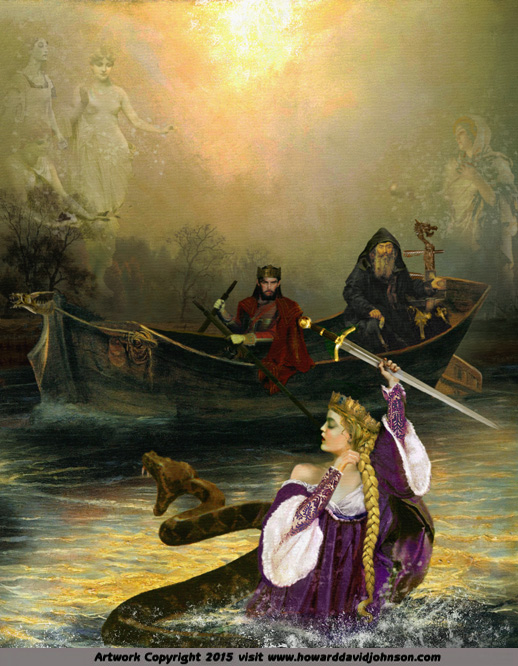 |
| "The Queen's Champion" | "King Arthur and Sir Lancelot" | "The Lady in the Lake" |
|
For a gallery with DOZENS of King Arthur paintings - CLICK HERE
|
||
|
Thank you for visiting The Celtic Myth & Legend art gallery of Howard David Johnson... Your business, letters, & links are always welcome.
|
||
|
Enter a world of Beauty and Imagination...
INDEX of GALLERIES ~
LINKS to LARGER ART The Realistic and Fantastic Art Galleries of Contemporary American Illustrator Howard David Johnson Click on these Fun Educational Realistic Art Gallery link icons for Two-fisted Tales of VALOR & Frontline Combat featuring Legendary Warriors of History, Knights and ladies of Arthurian Legend, Celtic, Nordic, Asian and Olympian gods & monsters, unicorns, dragons, fairies... and more! Your business, letters, & links are always welcome. All these pieces of art and the text are legally copyrighted and were registered with the U.S. Library of Congress Office of Copyright by the author, Howard David Johnson All rights reserved worldwide. Permission for many academic or non-commercial uses is freely and legally available by simply contacting the author via e-mail or visiting www.howarddavidjohnson.com/permission.htm |
|
This Gallery has been honored by more than 40,000,000 unique visitors from the Four Corners of the Earth: My Friends from around the world thus far : England, Canada, Scotland, Wales, Ireland, Germany, France, Monaco, Andorra, Italy, The Vatican City State, Greece, Macedonia, Cyprus, Turkey, Belgium, Denmark, The Faroe Islands, Greenland, Yugoslavia, Macedonia, Croatia, The Czech Republic, Bosnia, Herzegovina, Slovakia, Slovenia, Luxembourg, Latvia, Estonia, Hungary, Bulgaria, Lithuania, Poland, Austria, Romania, Spain, The Russian Federation, Ukraine, Kazakhstan, Moldova, Malta, Iceland, Finland, Norway, Netherlands, Switzerland, Liechtenstein, Sweden, Portugal, Albania, Armenia, Georgia, Azerbaijan, Belarus, Kazakhstan, Gibraltar, Israel, Palestinian Territories, Egypt, Libya, Mali, Algeria, Niger, Saudi Arabia, Oman, The United Arab Emirates, Kuwait, Bahrain, Qatar, Yemen, Iraq, Iran, Jordan, Syria, Lebanon, Morocco, Ethiopia, Eritrea, Liberia, The Republic of Congo, Rwanda, Kenya, Angola, Ghana, The Ivory Coast, Zambia, Zimbabwe, Sudan, Nigeria, Namibia, Uganda, Kenya, Eritrea, Tanzania, Botswana, Malawi, Senegal, Djibouti, Cameroon, Chad, Gambia, Mozambique, Swaziland, Lesotho, South Africa, Viet Nam, Japan, South Korea, China, Hong Kong, Macau, Mongolia, Mauritius, Singapore, Thailand, Cambodia, Laos, Myanmar, Macau, Malaysia, Taiwan, Nuie, New Zealand, Fiji, Cook Islands, New Caledonia, Vanuatu, American Samoa, Australia, Micronesia, Polynesia, Papua New Guinea, The Heard and McDonald Islands, The Philippines, Guam, Palau, Cocos Island, The Kingdom of Tonga, Malaysia, Brunei Darussalem, India, Pakistan, Afghanistan, Bhutan, Bangladesh, Sri Lanka, Chagos Islands, The Republic of Maldives, Turkmenistan, Kyrgyzstan, Uzbekistan, Nepal, Indonesia, Chile, Argentina, Uruguay, Paraguay, Brazil, Peru, Aruba, Venezuela, Bolivia, Suriname, Guyana, Aruba, The Dominican Republic, Guatemala, Costa Rica, Colombia, Trinidad and Tobago, Antigua and Barbuda, Barbados, The Virgin Islands, The Netherlands Antilles, Panama, Saint Vincent & Grenadines, Grenada, Ecuador, Belize, Nicaragua, El Salvador, Bermuda, Cuba, Jamaica, Dominica, Haiti, Puerto Rico, Cayman Islands, Anguilla, The Bahamas, Honduras, Mexico, and my home, The Great Free State of Idaho (USA)... If your home is not listed here please e-mail us and tell us where you're from... info@howarddavidjohnson.com Your business, letters, & links are always welcome. ***** |
|
The Ulster Saga and the chieftain gods of the Gaelic Celts
From THE ULSTER CYCLE coloured pencil plate # 9 shown actual size The terrible tragedy of the Irish Achilles: Cuchulainn unknowingly kills his abandoned son Conlaech. When I began working on these Gaelic Celtic Art illustrations in 1995 I employed the methods I learned as a scientific illustrator. I thought I was dealing with Mythology, which I define as a dead religion. I am so glad now that I treated the material with respect. What a surprise to find out after I exhibited them that this religion has revived in a new form. Of course I say a new form because claims that this Modern Celtic Paganism is the exact same religion practiced by the Druids and the Ancient Celts are impossible to substantiate. This is because the Ancient Celts, like the Pre-Historic Hebrews had no written language and relied on oral tradition. Because of this, the harpist was of incredible importance to the ancient Celts. The harp is the living symbol today of the Gaelic Celtic oral tradition and Celtic music is now celebrated all over the world. The only extant accounts of the Druids are brief mentions in the writings of Julius Caesar from the first century B.C. which go into no useful details whatsoever on this matter. I've heard it said: "Ask a hundred Pagans: What is Paganism and you're likely to get a hundred different answers." This does not make this any easier for contemporary scholars to sort out. However, It is my American Scots-Irish family's roots and cultural heritage after all and I feel what we do have is to be preserved and never to be treated lightly even if I don't believe any of the supernatural elements in it. These illustrations are based on my euhemeristic approach, which attributes the origin of the gods to the deification of historical heroes or real persons and events. I created these pictures to teach my children about their Gaelic Celtic heritage because I could find hardly any to show them when I told them the old stories. ( For more on my struggle to sort out history from mythology see the essay "How do we sort out History and Mythology?" below ). My scholarly Gaelic Celtic sources* and also, more art & my essays on art and art and technology follow."~Howard David Johnson Bibliography/ Acknowledgements some key text sources and recommended reading: Mr. E.W.B. Nicholson, M.A. "Keltic Researches" The Lady Wilde "Ancient Legends of Ireland" Crofton Croker "Fairy Legends and traditions of the South of Ireland" John Rhys: "Studies in the Arthurian Legend" and " Lectures on the Origin and Growth of Religion as Illustrated by Celtic Heathendom" Jo Kerrigan "Old Ways, Old Secrets: Pagan Ireland: Myth * Landscape * Tradition" Alfred Nutt: "Popular studies in Mythology, Romance, and Folklore" O'Curry: "Manners and Customs of the Ancient Irish" De Jubainville: "Cycle Mythologique Irlandais" Tacitus: " Annals" and "Agricola" Julius Caesar: "De Bello Gallico" Nennius: Historia Britonum Thank you for visiting The Celtic Myth & Legend art gallery of Howard David Johnson... Your business, letters, & links are always welcome.
*****
|
